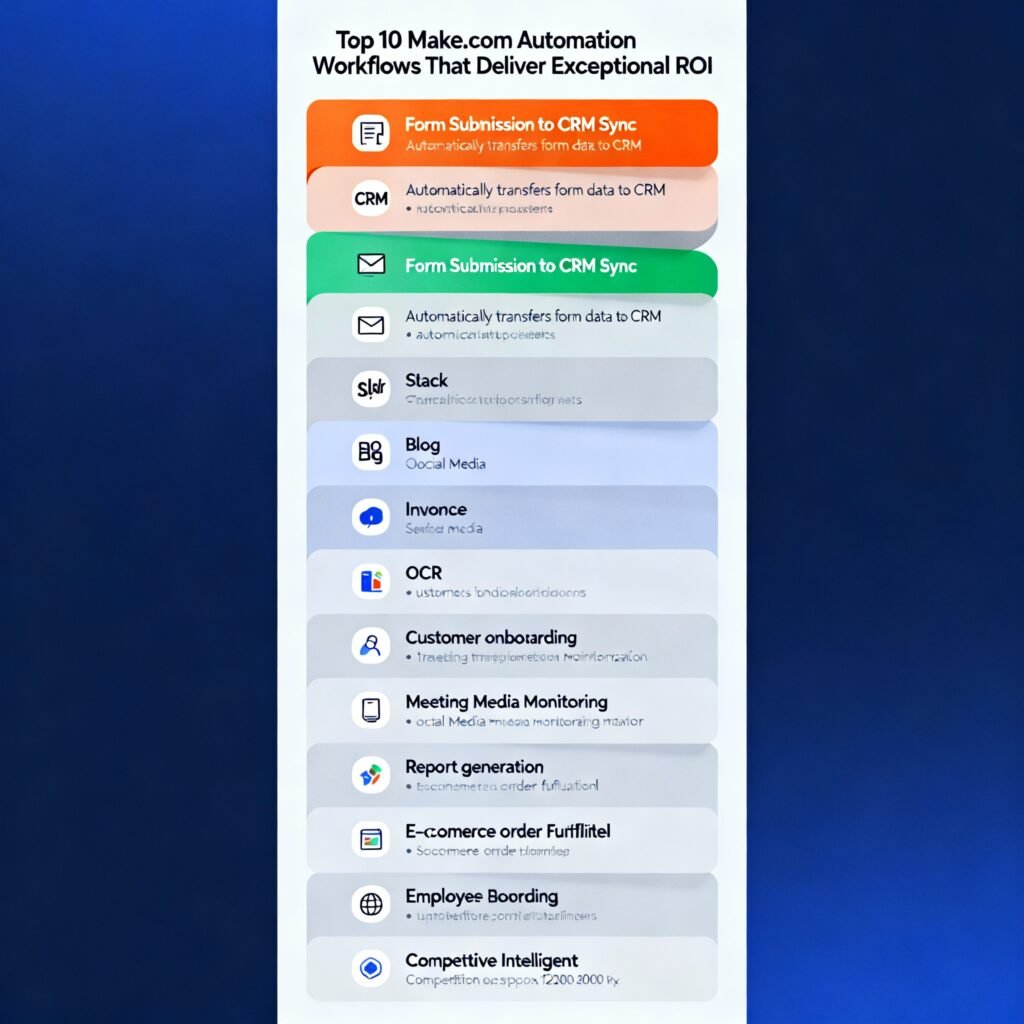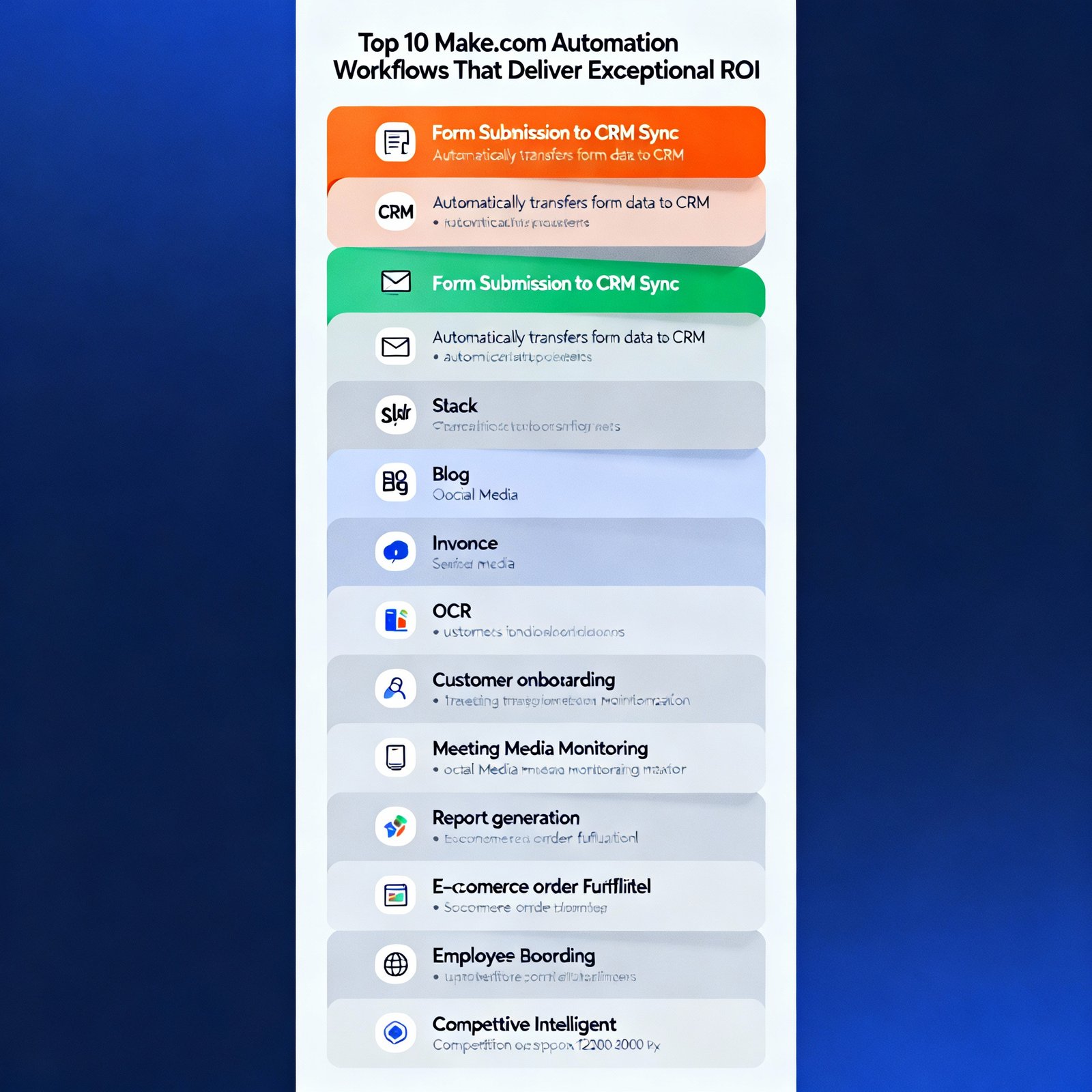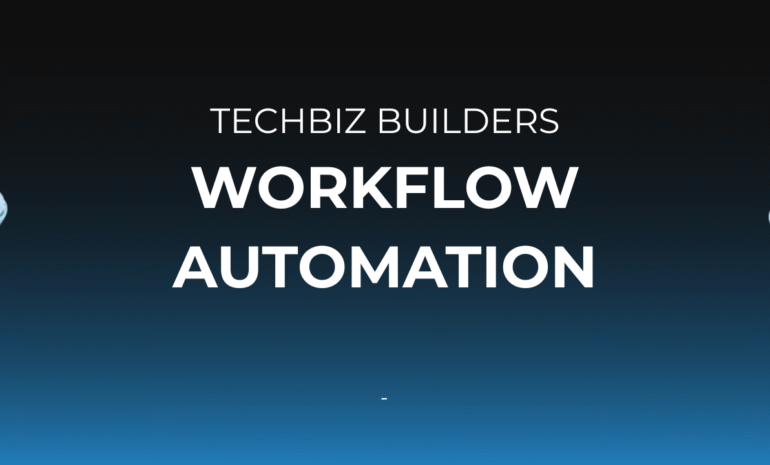Make.com is one of the most powerful automation platforms available, but most people barely scratch the surface of what’s possible. | Make.com workflows
I’ve built hundreds of Make.com scenarios for clients across industries, and certain patterns consistently deliver exceptional ROI. These ten workflows have proven their worth time and again.

Let me show you exactly what to build.
1. Automated Lead Enrichment and Routing
The Problem: Leads come in with minimal information. Sales teams waste time researching and determining who should handle each lead.
The Solution:
When a new lead submits a form, Make.com:
- Captures the submission
- Enriches data using Clearbit or Hunter.io (company size, industry, revenue)
- Scores the lead based on your criteria
- Assigns to the appropriate sales rep based on territory/specialization
- Creates a personalized CRM record with all enriched data
- Sends a customized introduction email
- Notifies the assigned rep in Slack with lead context
Time Saved: 15-20 minutes per lead Technical Difficulty: Intermediate Modules Needed: Webhook, HTTP requests, router, CRM integration, Gmail, Slack
2. Content Distribution Across Multiple Platforms
The Problem: Publishing content to multiple platforms takes forever and content often needs reformatting for each channel.
The Solution:
When you publish a blog post:
- Make.com detects the new post (via RSS or webhook)
- Extracts the content
- Uses GPT-4 to create platform-specific versions (Twitter thread, LinkedIn post, Instagram caption)
- Generates relevant images or graphics
- Schedules posts across all platforms at optimal times
- Tracks engagement in a central dashboard
Time Saved: 45-60 minutes per piece of content Technical Difficulty: Intermediate Modules Needed: RSS/Webhook, OpenAI, social media modules, scheduling
3. Automated Invoice Processing and Payment Tracking
The Problem: Invoices arrive via email in various formats. Tracking payments manually is tedious and error-prone.
The Solution:
When an invoice email arrives:
- Make.com extracts the PDF attachment
- Uses OCR/AI to extract invoice details (number, amount, due date, vendor)
- Creates a record in your accounting software
- Adds a calendar reminder 5 days before due date
- When payment is made, updates the record
- Sends a receipt to the vendor
- Updates your expense tracking dashboard
Time Saved: 10-15 minutes per invoice Technical Difficulty: Advanced Modules Needed: Gmail, PDF parsing, accounting software, calendar, notification system
4. Customer Onboarding Automation
The Problem: New customers need multiple touchpoints across different tools. Manual onboarding is time-consuming and inconsistent.
The Solution:
When someone becomes a customer:
- Creates accounts across all necessary platforms
- Generates personalized welcome email with their specific details
- Schedules a series of onboarding emails based on their plan type
- Creates a project in your PM tool with standard onboarding tasks
- Assigns a customer success manager
- Sends an internal notification with customer context
- Starts tracking onboarding progress
Time Saved: 30-40 minutes per customer Technical Difficulty: Intermediate Modules Needed: CRM, email marketing, project management, router for conditional logic
5. Meeting Recording to Action Items
The Problem: Meeting insights get lost. Action items aren’t consistently tracked. Meeting notes are incomplete or never written.
The Solution:
After a recorded meeting:
- Make.com fetches the recording from Zoom/Meet
- Sends audio to transcription service
- Uses GPT-4 to analyze transcript and extract:
- Key decisions made
- Action items with owners
- Important discussion points
- Next steps
- Creates tasks in your project management tool assigned to relevant people
- Sends summary email to all participants
- Updates relevant project documentation
Time Saved: 20-30 minutes per meeting Technical Difficulty: Intermediate Modules Needed: Zoom/Google Meet, transcription service, OpenAI, project management, email
6. Social Media Monitoring and Response
The Problem: Monitoring multiple social platforms is time-consuming. Important mentions get missed. Response times lag.
The Solution:
Continuous monitoring that:
- Tracks brand mentions across Twitter, LinkedIn, Facebook, Instagram
- Categorizes mentions by sentiment and urgency
- For positive mentions: Auto-likes and adds to a “testimonials” database
- For questions: Drafts responses using AI based on your knowledge base
- For negative mentions: Creates urgent tasks and sends immediate team alerts
- For opportunities (like partnership inquiries): Routes to appropriate team member
- Tracks all interactions in a central dashboard
Time Saved: 2-3 hours per week Technical Difficulty: Advanced Modules Needed: Social media APIs, sentiment analysis, OpenAI, routing logic, notification systems
7. Automated Report Generation and Distribution
The Problem: Creating weekly/monthly reports manually is tedious. Data lives in multiple systems. Reports are often delayed.
The Solution:
On a schedule (weekly/monthly):
- Pulls data from all relevant sources (Google Analytics, CRM, ad platforms, financial tools)
- Compiles key metrics
- Generates trend analysis and insights using AI
- Creates visualizations
- Formats everything into a professional report template
- Personalizes reports for different stakeholders (executive summary vs. detailed)
- Distributes via email to appropriate teams
- Archives in Google Drive/SharePoint
Time Saved: 2-4 hours per report Technical Difficulty: Advanced Modules Needed: Multiple API connections, data aggregation, OpenAI, Google Docs/Slides, email
8. E-commerce Order Fulfillment Workflow
The Problem: Order processing involves multiple steps across different systems. Manual coordination causes delays and errors.
The Solution:
When a new order is placed:
- Captures order details from your store
- Checks inventory levels
- If in stock: Creates fulfillment task, generates shipping label, updates inventory
- If out of stock: Notifies purchasing team, emails customer with ETA
- Sends order confirmation with personalized message
- Updates accounting records
- After shipment: Sends tracking info to customer
- Three days after delivery: Sends review request
- Adds customer to appropriate marketing segment
Time Saved: 15-20 minutes per order Technical Difficulty: Intermediate Modules Needed: E-commerce platform, inventory system, shipping API, email, CRM
9. Employee Onboarding Automation
The Problem: New employee onboarding involves coordination across HR, IT, and multiple departments. Things fall through cracks.
The Solution:
When a new employee is added to HR system:
- Creates accounts (email, Slack, project management, other tools)
- Generates and sends welcome package
- Creates onboarding task checklist with assignments and due dates
- Schedules automated check-ins at day 1, week 1, month 1
- Orders equipment through procurement system
- Assigns an onboarding buddy
- Schedules introductory meetings with key team members
- Tracks completion of required training and documentation
Time Saved: 3-4 hours per new hire Technical Difficulty: Advanced Modules Needed: HR system, IT systems, email, Slack, project management, calendar
10. Competitive Intelligence Monitoring
The Problem: Staying aware of competitor activities requires constant monitoring. Important changes get missed.
The Solution:
Continuous monitoring that:
- Tracks competitor websites for changes (pricing, products, content)
- Monitors their social media for announcements
- Watches for news mentions using news APIs
- Analyzes changes using AI to determine significance
- For significant changes: Creates detailed analysis and alerts leadership
- For minor changes: Logs to competitor tracking database
- Generates weekly competitive intelligence digest
- Identifies patterns and trends over time
Time Saved: 5-6 hours per week Technical Difficulty: Advanced Modules Needed: Web scraping, news APIs, social monitoring, OpenAI analysis, notification system
Implementation Tips for Success
Start simple: Don’t try to build the perfect workflow on day one. Get a basic version working, then iterate.
Test thoroughly: Use Make.com’s manual run feature to test each module before activating automated triggers.
Add error handling: Use error handlers to catch failures gracefully. Always have a notification system for critical failures.
Monitor usage: Keep an eye on your operations count. Optimize scenarios that consume too many operations.
Document your workflows: Future you will appreciate notes on what each scenario does and why decisions were made.
The Make.com Features That Make This Possible
Routers: Send data down different paths based on conditions Iterators: Process arrays of data item by item Aggregators: Combine multiple results into one Error handlers: Gracefully manage failures Data stores: Temporarily store data between workflow runs Scheduling: Run scenarios on custom schedules
Master these features, and you can build virtually any automation.
Your Next Steps
Choose one workflow from this list that addresses your biggest pain point. Don’t try to implement all ten at once.
Spend a week building and testing that single workflow. Once it’s running smoothly, move to the next one.
Six months from now, you’ll have most of these running, and you’ll wonder how you ever managed without them.
The businesses winning in 2025 are the ones that automate strategically. Start today.



